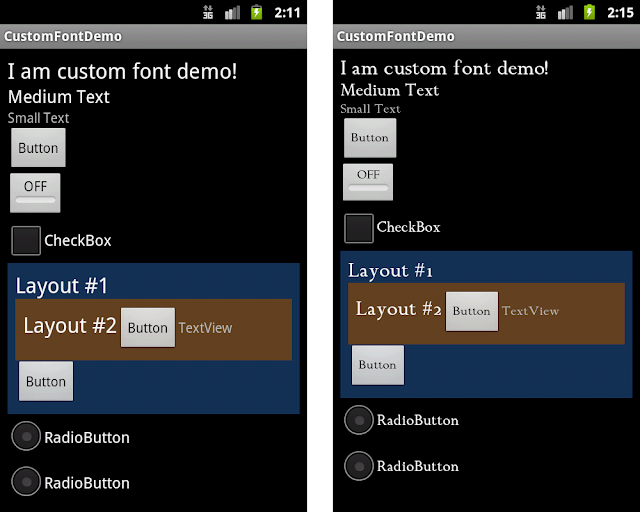【Android 界面效果42】如何自定义字体
项目里要统一用设计师的字体,android:typeface只支持系统三种字体。有什么比较好的做法?
你需要为整个应用替换自定义字体。
解决方案
1)Android默认方法 #1
你可以通过ID查找到View,然后挨个为它们设置字体。在单个View的情况下,它看起来也没有那么可怕。
Typeface customFont = Typeface.createFromAsset(this.getAssets(), "fonts/YourCustomFont.ttf");
TextView view = (TextView) findViewById(R.id.activity_main_header);
view.setTypeface(customFont);
但是在很多TextView、Button等文本组件的情况下,我敢肯定你不会喜欢这个方法的。:D
2)Android默认方法 #2
你可以为每个文本组件创建一个子类,如TextView、Button等,然后在构造函数中加载自定义字体。
public class BrandTextView extends TextView {
public BrandTextView(Context context, AttributeSet attrs, int defStyle) {
super(context, attrs, defStyle);
}
public BrandTextView(Context context, AttributeSet attrs) {
super(context, attrs);
}
public BrandTextView(Context context) {
super(context);
}
public void setTypeface(Typeface tf, int style) {
if (style == Typeface.BOLD) {
super.setTypeface(Typeface.createFromAsset(getContext().getAssets(), "fonts/YourCustomFont_Bold.ttf"));
} else {
super.setTypeface(Typeface.createFromAsset(getContext().getAssets(), "fonts/YourCustomFont.ttf"));
}
}
}
然后只需要将标准的文本控件替换成你自定义的就可以了(例如BrandTextView替换TextView)。
<com.your.package.BrandTextView
android:layout_width="wrap_content"你需要为整个应用替换自定义字体。
解决方案
1)Android默认方法 #1
你可以通过ID查找到View,然后挨个为它们设置字体。在单个View的情况下,它看起来也没有那么可怕。
Typeface customFont = Typeface.createFromAsset(this.getAssets(), "fonts/YourCustomFont.ttf");
TextView view = (TextView) findViewById(R.id.activity_main_header);
view.setTypeface(customFont);
但是在很多TextView、Button等文本组件的情况下,我敢肯定你不会喜欢这个方法的。:D
2)Android默认方法 #2
你可以为每个文本组件创建一个子类,如TextView、Button等,然后在构造函数中加载自定义字体。
public class BrandTextView extends TextView {
public BrandTextView(Context context, AttributeSet attrs, int defStyle) {
super(context, attrs, defStyle);
}
public BrandTextView(Context context, AttributeSet attrs) {
super(context, attrs);
}
public BrandTextView(Context context) {
super(context);
}
public void setTypeface(Typeface tf, int style) {
if (style == Typeface.BOLD) {
super.setTypeface(Typeface.createFromAsset(getContext().getAssets(), "fonts/YourCustomFont_Bold.ttf"));
} else {
super.setTypeface(Typeface.createFromAsset(getContext().getAssets(), "fonts/YourCustomFont.ttf"));
}
}
}
然后只需要将标准的文本控件替换成你自定义的就可以了(例如BrandTextView替换TextView)。
<com.your.package.BrandTextView
android:layout_width="wrap_content"
android:layout_height="wrap_content"
android:text="View with custom font"/>
<com.your.package.BrandTextView
android:layout_width="wrap_content"
android:layout_height="wrap_content"
android:textStyle="bold"
android:text="View with custom font and bold typeface"/>
还有,你甚至可以直接在XML中添加自定义的字体属性。要实现这个,你需要定义你自己的declare-styleable属性,然后在组件的构造函数中解析它们。
为了不占篇幅介绍这么基础的东西,这里有一篇不错的文章告诉你怎么自定义控件属性。
http://kevindion.com/2011/01/custom-xml-attributes-for-android-widgets/
在大多数情况下,这个方法还不赖,并且有一些优点(例如,切换字体粗细等等,字体可以在组件xml文件的typeface属性中定义)。但是我认为这个实现方法还是太重量级了,并且依赖大量的模板代码,为了一个替换字体的简单任务,有点儿得不偿失。
3)我的解决方案
理想的解决方案是自定义主题,然后应用到全局或者某个Activity。
但不幸的是,Android的android:typeface属性只能用来设置系统内嵌的字体,而非用户自定义字体(例如assets文件中的字体)。这就是为什么我们无法避免在Java代码中加载并设置字体。
所以我决定创建一个帮助类,使得这个操作尽可能的简单。使用方法:
FontHelper.applyFont(context, findViewById(R.id.activity_root), "fonts/YourCustomFont.ttf");
并且这行代码会用来加载所有的基于TextView的文本组件(TextView、Button、RadioButton、ToggleButton等等),而无需考虑界面的布局层级如何。
标准(左)与自定义(右)字体的用法。

这是怎么做到的?非常简单:
public static void applyFont(final Context context, final View root, final String fontName) {
try {
if (root instanceof ViewGroup) {
ViewGroup viewGroup = (ViewGroup) root;
for (int i = 0; i < viewGroup.getChildCount(); i++)
applyFont(context, viewGroup.getChildAt(i), fontName);
} else if (root instanceof TextView)
((TextView) root).setTypeface(Typeface.createFromAsset(context.getAssets(), fontName));
} catch (Exception e) {
Log.e(TAG, String.format("Error occured when trying to apply %s font for %s view", fontName, root));
e.printStackTrace();
}
}
正如你所看到的,所需要做的仅仅是将基于TextView的文本组件从布局中遍历出来而已。
你可以在这里下载到示例代码,里面有FontHelper的具体用法。
一些想法
在多个项目中,我都碰到过类似的需求,早期采用的是第二种实现方法,但是缺点在于对于第三方组件,你需要去修改别人的代码,才能实现自定义字体,这恰恰违反了OC(Open & Close)原则,对扩展开放,对修改封闭。
刚看到第三种的时候,也是惊为天人,姑且不说结果,我觉得这种活跃的思路非常重要,很值得学习参考。
但是最后被team里的人否决了,理由是违背组件设计原则,实现方式略嫌粗暴。后来我仔细想想,一个是要做好内存管理(似乎会引起内存问题),视图状态改变,也要重复加载(横竖屏、onResume等),也绝对不是简单的活儿。
所以暂定使用第一种方法,typeface使用单例,需要时设置字体。
我个人觉得第一种还是个体力活,而且到后来,这个代码重复率还是非常高的,这又违背了DRY原则。
在地铁上的时候,突然想到DI(Dependency Inject)。已经有一些DI的框架,如ButterKnife,那写出来应该是这样:
@CustomFont(R.id.textView) TextView textView
or
@InjectView(id=R.id.textView, customFont=true) View anyView
@InjectView(id=R.id.textView, customFont=true, customFont="fonts/ltfz.ttf") View anyView
这样写出来代码相比重复写setTypeface要好一些。
目前我们的项目还没有使用这类DI框架,等以后引入了,使用第二种注入,写起来应该是很爽的。
具体看我博客:【译】Android:更好的自定义字体方法
android:layout_height="wrap_content" android:text="View with custom font"/> <com.your.package.BrandTextView android:layout_width="wrap_content" android:layout_height="wrap_content" android:textStyle="bold" android:text="View with custom font and bold typeface"/> 还有,你甚至可以直接在XML中添加自定义的字体属性。要实现这个,你需要定义你自己的declare-styleable属性,然后在组件的构造函数中解析它们。
为了不占篇幅介绍这么基础的东西,这里有一篇不错的文章告诉你怎么自定义控件属性。
http://kevindion.com/2011/01/custom-xml-attributes-for-android-widgets/
在大多数情况下,这个方法还不赖,并且有一些优点(例如,切换字体粗细等等,字体可以在组件xml文件的typeface属性中定义)。但是我认为这个实现方法还是太重量级了,并且依赖大量的模板代码,为了一个替换字体的简单任务,有点儿得不偿失。
3)我的解决方案
理想的解决方案是自定义主题,然后应用到全局或者某个Activity。
但不幸的是,Android的android:typeface属性只能用来设置系统内嵌的字体,而非用户自定义字体(例如assets文件中的字体)。这就是为什么我们无法避免在Java代码中加载并设置字体。
所以我决定创建一个帮助类,使得这个操作尽可能的简单。使用方法:
FontHelper.applyFont(context, findViewById(R.id.activity_root), "fonts/YourCustomFont.ttf");
并且这行代码会用来加载所有的基于TextView的文本组件(TextView、Button、RadioButton、ToggleButton等等),而无需考虑界面的布局层级如何。
标准(左)与自定义(右)字体的用法。

这是怎么做到的?非常简单:
public static void applyFont(final Context context, final View root, final String fontName) {
try {
if (root instanceof ViewGroup) {
ViewGroup viewGroup = (ViewGroup) root;
for (int i = 0; i < viewGroup.getChildCount(); i++)
applyFont(context, viewGroup.getChildAt(i), fontName);
} else if (root instanceof TextView)
((TextView) root).setTypeface(Typeface.createFromAsset(context.getAssets(), fontName));
} catch (Exception e) {
Log.e(TAG, String.format("Error occured when trying to apply %s font for %s view", fontName, root));
e.printStackTrace();
}
}
正如你所看到的,所需要做的仅仅是将基于TextView的文本组件从布局中遍历出来而已。
你可以在这里下载到示例代码,里面有FontHelper的具体用法。
一些想法
在多个项目中,我都碰到过类似的需求,早期采用的是第二种实现方法,但是缺点在于对于第三方组件,你需要去修改别人的代码,才能实现自定义字体,这恰恰违反了OC(Open & Close)原则,对扩展开放,对修改封闭。
刚看到第三种的时候,也是惊为天人,姑且不说结果,我觉得这种活跃的思路非常重要,很值得学习参考。
但是最后被team里的人否决了,理由是违背组件设计原则,实现方式略嫌粗暴。后来我仔细想想,一个是要做好内存管理(似乎会引起内存问题),视图状态改变,也要重复加载(横竖屏、onResume等),也绝对不是简单的活儿。
所以暂定使用第一种方法,typeface使用单例,需要时设置字体。
我个人觉得第一种还是个体力活,而且到后来,这个代码重复率还是非常高的,这又违背了DRY原则。
在地铁上的时候,突然想到DI(Dependency Inject)。已经有一些DI的框架,如ButterKnife,那写出来应该是这样:
@CustomFont(R.id.textView) TextView textView
or
@InjectView(id=R.id.textView, customFont=true) View anyView
@InjectView(id=R.id.textView, customFont=true, customFont="fonts/ltfz.ttf") View anyView
这样写出来代码相比重复写setTypeface要好一些。
目前我们的项目还没有使用这类DI框架,等以后引入了,使用第二种注入,写起来应该是很爽的。
具体看我博客:【译】Android:更好的自定义字体方法





